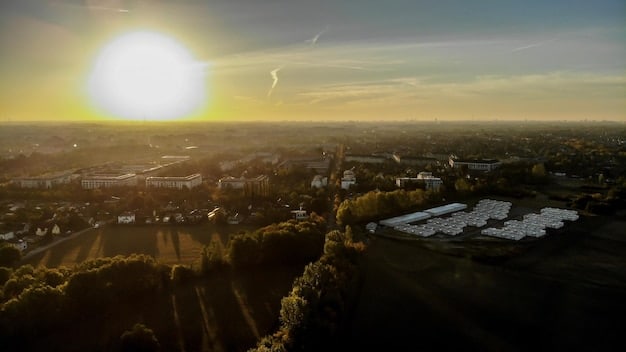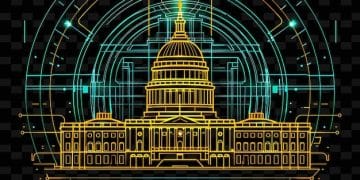Government Invests $5 Billion in Renewable Energy: New US Jobs

The U.S. government announced a substantial $5 billion investment in renewable energy infrastructure, a strategic move poised to significantly boost the clean energy sector and foster widespread job creation across the nation, addressing both climate goals and economic growth.
The United States government has recently unveiled a monumental initiative: a $5 billion investment in renewable energy infrastructure, creating new jobs nationwide. This strategic allocation of funds marks a pivotal moment in the nation’s energy transition, signaling a robust commitment to combating climate change while simultaneously stimulating economic growth and fostering innovation. This unprecedented investment is not merely about funding new projects; it’s about building a sustainable future, generating thousands of opportunities, and positioning the U.S. as a leader in clean energy technology.
Understanding the $5 Billion Renewable Energy Initiative
The recently announced $5 billion government investment is a comprehensive plan designed to accelerate the deployment of clean energy technologies across the United States. This funding is targeted at various segments of the renewable energy sector, including solar, wind, geothermal, hydropower, and emerging technologies like green hydrogen and advanced battery storage. The initiative aims to modernize the nation’s energy grid, enhance energy independence, and deliver widespread economic benefits.
The Department of Energy, in collaboration with other federal agencies, will oversee the distribution and implementation of these funds. A significant portion is earmarked for direct investment in large-scale infrastructure projects, such as new solar farms and offshore wind installations, which require substantial upfront capital. Furthermore, the plan includes provisions for research and development to foster innovation in renewable energy technologies, ensuring that the U.S. remains at the forefront of this rapidly evolving industry. This holistic approach ensures that the investment covers not just deployment, but also the foundational elements for future growth and technological advancement.
The Strategic Allocation of Funds
The government’s $5 billion investment strategy is multifaceted, aiming to address critical gaps in the existing energy infrastructure while simultaneously supporting emerging technologies. The allocation is designed to maximize impact across various sectors, creating a ripple effect of benefits nationwide.
* Grid Modernization: A significant portion will be dedicated to upgrading and fortifying the nation’s aging electricity grid. This includes investments in smart grid technologies, energy storage solutions, and transmission lines capable of handling increased renewable energy loads. A modern grid is essential for integrating intermittent renewable sources effectively.
* Renewable Energy Project Development: Direct funding will support the construction of utility-scale renewable energy installations, such as massive solar parks in the desert states and extensive offshore wind farms along the coastlines. These projects are capital-intensive and require sustained investment to reach commercial viability.
* Research and Development (R&D): Investing in R&D is crucial for long-term sustainability and competitiveness. Funds will be channeled into institutions and private companies focusing on breakthroughs in solar cell efficiency, advanced wind turbine designs, geothermal extraction techniques, and sustainable biofuel production.
* Community Resilience and Access: A portion of the investment will also focus on fostering renewable energy projects in underserved communities, promoting energy equity, and building localized microgrids that can withstand severe weather events and provide reliable power.
* Workforce Training and Development: Crucially, a significant emphasis is placed on preparing the American workforce for the jobs of the future. This includes funding for vocational training programs, apprenticeships, and educational initiatives aimed at equipping individuals with the skills needed to design, build, and maintain renewable energy systems.
This strategic allocation ensures that the investment creates a robust ecosystem for renewable energy, from cutting-edge research to on-the-ground project implementation and workforce development. The goal is not just to install more renewable capacity, but to build a resilient, efficient, and equitable energy system for generations to come.
Timeline and Expected Milestones
The implementation of this ambitious initiative is expected to unfold over the next five to seven years, with several key milestones along the way. The initial phase will focus on establishing the administrative frameworks, selecting priority projects, and initiating the first wave of funding disbursements. By the end of the first year, several new large-scale renewable energy projects are anticipated to break ground, signaling tangible progress. Over the subsequent years, an increasing number of projects, both large and small, will come online, contributing to the nation’s renewable energy capacity. The government plans regular reports detailing job creation, energy output, and carbon emission reductions, ensuring transparency and accountability throughout the process. This phased approach allows for adaptive planning and incorporates lessons learned from early implementations, guaranteeing the most effective use of taxpayer dollars.
Job Creation: A Nationwide Impact
One of the most compelling aspects of the $5 billion investment is its direct link to job creation across the United States. The renewable energy sector is labor-intensive, requiring a diverse workforce ranging from engineers and researchers to construction workers, technicians, and project managers. This initiative is projected to generate hundreds of thousands of new jobs, revitalizing local economies and offering sustainable career paths. These jobs are not concentrated in a single region; they will be distributed nationwide, touching urban centers and rural communities alike, providing opportunities in various technical and non-technical fields.
The jobs created will span the entire value chain of renewable energy projects. From manufacturing component parts, such as solar panels and wind turbine blades, to the actual construction and installation of these systems, and finally, their ongoing maintenance and operation, a vast array of skills will be required. Moreover, indirect job creation will occur in supporting industries, including logistics, finance, and specialized consulting services. This dynamic employment landscape will foster new educational and training programs to prepare the workforce for these emerging opportunities.

Diverse Employment Opportunities from Renewable Energy
The expansion of renewable energy infrastructure promises a wide array of employment opportunities, far beyond what might initially be imagined. This investment will require a multifaceted workforce, drawing from various skill sets and educational backgrounds.
* Construction and Installation: This is arguably the most immediate and visible impact. Thousands of skilled tradespeople, including electricians, pipefitters, ironworkers, and general laborers, will be needed for the construction of solar farms, wind turbine installations, geothermal plants, and hydropower facilities. These roles are often unionized and can provide stable, well-paying jobs.
* Manufacturing and Supply Chain: As demand for renewable technologies grows, so too will the need for domestic manufacturing. This includes factories producing solar panels, wind turbine components (blades, nacelles), batteries, and specialized equipment for grid modernization. This sector will create jobs for production line workers, engineers, quality control specialists, and logistics personnel.
* Operations and Maintenance (O&M): Once renewable energy assets are built, they need continuous monitoring, maintenance, and repair. This provides long-term employment for technicians specializing in wind turbine maintenance, solar panel cleaning, battery system diagnostics, and grid operations. These roles often require specialized training and offer competitive wages.
* Research, Development, and Design: Innovation is key to advancing renewable energy technologies. Scientists, engineers, and researchers will be in high demand to develop more efficient solar cells, advanced energy storage solutions, resilient grid technologies, and new forms of renewable energy. Architects and urban planners will also play a role in integrating renewable solutions into communities.
* Support Services: A robust renewable energy sector also necessitates a strong support system. This includes jobs in legal and regulatory affairs, finance (project financing, investment analysis), environmental consulting, education and training, software development for smart grid management, and public relations.
The sheer breadth of these roles underscores the transformative potential of renewable energy investment on the national job market. It’s a fundamental shift, moving away from traditional energy sector roles into a new era of clean, sustainable employment. Each of these job categories contributes to a resilient and forward-looking energy economy.
Regional Job Growth Projections
The job growth from this investment is not expected to be uniform across the nation; rather, it will be concentrated in regions with specific resources and existing infrastructure. For instance, states in the Sun Belt are poised to see a surge in solar energy development and related construction jobs. The Midwest, with its vast open spaces and strong wind corridors, is expected to become a hub for wind turbine manufacturing and installation. Coastal states will benefit immensely from offshore wind projects, requiring specialized marine construction and maintenance crews. Even states with a history of fossil fuel production are actively diversifying, with increasing investments in geothermal and carbon capture technologies that could leverage existing skilled labor. Each region will develop its unique specialization in the renewable energy supply chain.
For example, California and Texas, already leaders in renewable energy, will likely see accelerated growth due to their established industries and policy frameworks. The Northeast, particularly states like New York and Massachusetts, is set to be a major beneficiary of offshore wind developments, creating numerous maritime and port-related jobs. The Southeast, with its growing manufacturing base, could attract new facilities for renewable component production. These regional specializations foster competitive advantages and promote localized economic ecosystems.
Reducing Carbon Emissions and Combating Climate Change
Beyond economic benefits, a primary objective of this $5 billion investment is to accelerate the transition away from fossil fuels, thereby significantly reducing carbon emissions. Renewable energy sources inherently produce little to no greenhouse gas emissions during operation, making them critical in the fight against climate change. By deploying more solar, wind, and other clean energy technologies, the nation can substantially decrease its carbon footprint and meet ambitious climate targets. This strategic pivot is essential for safeguarding environmental health and ensuring a livable planet for future generations.
The scale of this investment indicates a serious commitment to decarbonization. Replacing fossil fuel-powered electricity generation with renewable alternatives is one of the most effective ways to lower national emissions. The integration of advanced energy storage solutions funded by this initiative will also help overcome the intermittency challenge of renewables, ensuring a stable and reliable supply of clean power. This comprehensive approach is designed to create a resilient, low-carbon energy system that can withstand the challenges of climate change while providing consistent energy access.
Environmental Benefits Beyond Carbon Reduction
The shift to renewable energy offers a multitude of environmental benefits that extend far beyond simply reducing carbon emissions. These advantages collectively contribute to a healthier planet and improved quality of life for communities.
* Improved Air Quality: Unlike fossil fuel power plants, renewable energy sources like solar and wind do not release harmful airborne pollutants such as sulfur dioxide, nitrogen oxides, and particulate matter. These pollutants are known to cause respiratory illnesses, acid rain, and smog. A greater reliance on renewables directly translates to cleaner air, particularly in urban and industrial areas.
* Reduced Water Usage: Many conventional power plants, especially thermoelectric ones, require vast amounts of water for cooling. Hydroelectric power, while requiring water impoundment, generally consumes less water during operation compared to thermal plants. Solar and wind power use minimal to no water during their operational phase, preserving precious freshwater resources.
* Less Land Disturbance from Fuel Extraction: The extraction and transportation of fossil fuels often involve significant land disturbance from mining, drilling, and pipeline construction. Renewable energy sources, once installed, have a comparatively smaller land footprint per unit of energy produced and do not require continuous fuel extraction, preserving natural habitats and ecosystems.
* Lower Risk of Environmental Disasters: While no energy source is entirely without risk, renewables significantly reduce the potential for large-scale environmental disasters associated with fossil fuels, such as oil spills, coal ash contamination, and natural gas leaks. This contributes to safer ecosystems and reduced remediation costs.
* Resource Conservation: Renewable energy sources harness naturally replenished resources (sunlight, wind, water) rather than finite fossil fuels. This conserves non-renewable resources for other essential uses and ensures long-term energy security without depleting planetary reserves.
These ancillary environmental benefits underscore the holistic positive impact of embracing renewable energy. It represents a more sustainable and less impactful way to generate the power needed for modern society.
Achieving National and International Climate Goals
This $5 billion investment is a significant step towards achieving the United States’ climate goals, both domestically and as part of its international commitments. The nation has pledged to reduce its greenhouse gas emissions by 50-52% below 2005 levels by 2030, a target that necessitates rapid decarbonization of the energy sector. This investment will accelerate the deployment of clean energy technologies, making significant inroads towards this ambitious short-term goal. Furthermore, by demonstrating strong commitment to a clean energy future, the U.S. reinforces its leadership role in global climate diplomacy, encouraging other nations to follow suit. This commitment is vital for the success of international agreements like the Paris Agreement, where global cooperation is paramount to addressing the climate crisis effectively. The collective efforts, spurred by such investments, are humanity’s best chance at mitigating the severe impacts of a warming planet.
Technological Advancements and Innovation Boost
The federal outlay of $5 billion is not solely for deploying existing renewable technologies; it also serves as a potent catalyst for technological advancements and innovation within the clean energy sector. By providing substantial funding for research, development, and demonstration projects, the initiative fosters breakthroughs that will make renewable energy more efficient, cost-effective, and versatile. This push for innovation is crucial for overcoming current technological limitations and unlocking the full potential of various renewable sources, ensuring sustained growth and competitiveness.
This investment will stimulate private sector innovation by signaling government commitment and reducing financial risks for nascent technologies. It encourages startups and established companies alike to invest in new solutions, from advanced battery storage systems and smart grid integration tools to novel materials for solar panels and more efficient wind turbine designs. The synergy between government support and private enterprise is essential for accelerating the energy transition.
Cutting-Edge Projects Receiving Investment
Several pioneering projects and technologies are set to receive significant funding from this $5 billion investment, pushing the boundaries of what is possible in renewable energy. These include initiatives that were previously too risky or capital-intensive for purely private funding.
* Advanced Geothermal Systems: Unlike conventional geothermal, which relies on specific geological hot spots, advanced geothermal systems (AGS) use enhanced techniques to extract heat from deeper, hotter rocks, making geothermal energy accessible in wider geographical areas. This includes closed-loop systems that minimize water use and environmental impact.
* Green Hydrogen Production: Funding will support pilot projects for producing green hydrogen – hydrogen generated through electrolysis powered by renewable electricity. Green hydrogen is seen as a key decarbonization tool for heavy industries, long-haul transport, and seasonal energy storage.
* Next-Generation Grid Storage: Beyond traditional lithium-ion batteries, investments are being made in long-duration energy storage technologies, such as flow batteries, compressed air energy storage (CAES), and potentially even thermal storage. These are vital for balancing renewable energy intermittency and enhancing grid reliability.
* Offshore Wind Transmission Networks: To fully integrate the vast potential of offshore wind, funds will be allocated to innovative transmission solutions, including high-voltage direct current (HVDC) lines and subsea cables that can efficiently deliver power from remote offshore wind farms to population centers.
* Carbon Capture and Utilization (CCU): While not strictly renewable energy, CCU technologies are crucial for decarbonizing hard-to-abate sectors. Funds will support projects that capture CO2 directly from industrial sources or the air and convert it into useful products, preventing its release into the atmosphere.
These are just a few examples of the ambitious projects that the government’s investment aims to catalyze. By backing these cutting-edge endeavors, the U.S. is not only advancing its climate goals but also solidifying its position as a global leader in clean energy innovation. The successful implementation of these projects could revolutionize the future of energy production and consumption nationwide.
Fostering a Culture of Clean Energy Innovation
The investment goes beyond direct funding for projects, aiming to cultivate a thriving ecosystem for clean energy innovation. This involves supporting research universities, national laboratories, and private sector incubators where new ideas can be tested and scaled. Government grants and incentives will encourage scientists and entrepreneurs to tackle complex energy challenges, fostering cross-disciplinary collaboration. By creating an environment where risk-taking is encouraged and intellectual property is protected, the U.S. can become a global hub for clean energy technological development, attracting top talent and investment from around the world. This culture of innovation ensures that the nation continually pushes the boundaries of what’s possible in sustainable energy.
Strengthening Energy Security and Independence
A significant, albeit often understated, benefit of the $5 billion investment in renewable energy is its profound impact on national energy security and independence. By diversifying the energy portfolio away from volatile global fossil fuel markets, the United States strengthens its resilience against geopolitical instabilities and price fluctuations. Domestic renewable energy sources, such as sunlight and wind, are abundant and not subject to the same supply chain disruptions or political pressures as imported fuels. This transition reduces reliance on foreign energy sources, enhancing the nation’s strategic autonomy and economic stability.
Furthermore, a decentralized energy system, built on robust renewable grids, makes the nation less vulnerable to large-scale outages caused by natural disasters or cyberattacks. Localized renewable energy generation and storage capabilities can ensure continuous power supply even if central grid infrastructure is compromised. This distributed resilience is a critical component of modern energy security strategies. The move towards energy independence also allows for reallocation of resources previously spent on securing foreign oil supplies, freeing them up for domestic investments and national priorities.
Reducing Volatility in Energy Prices
One of the most immediate benefits of an increased reliance on renewable energy is the potential to reduce volatility in energy prices for consumers and businesses. Fossil fuel prices are notoriously susceptible to global market forces, geopolitical events, and supply-demand imbalances, leading to unpredictable fluctuations that impact household budgets and industrial costs.
* Stable Fuel Costs: The “fuel” for solar and wind power—sunlight and wind—is free and infinite. Once the initial infrastructure is built, the marginal cost of generating electricity is near zero. This eliminates the price volatility associated with purchasing and transporting fossil fuels.
* Long-Term Price Predictability: Renewable energy projects can often secure long-term power purchase agreements (PPAs) at stable, predictable prices. This provides certainty for utilities and consumers, allowing for better financial planning and reducing the risk of sudden price spikes.
* Diversification Benefits: A diversified energy mix, with a strong renewable component, acts as a hedge against price shocks in any single energy commodity. If oil or natural gas prices surge, renewable sources can help absorb some of the demand, mitigating the overall impact on the energy market.
* Investment in Infrastructure Over Commodities: The economic value shifts from purchasing finite commodities to investing in durable infrastructure. This creates long-term domestic jobs and retains wealth within the national economy rather than sending it abroad to energy-producing nations.
By insulating itself from the turbulent international energy markets, the U.S. can achieve greater economic stability and provide more affordable, predictable energy to its citizens and industries, fostering greater confidence in long-term economic planning. This shift is a significant move towards greater economic resilience.
Grid Resilience and Decentralization Benefits
The $5 billion investment will significantly bolster grid resilience through decentralization and the integration of advanced technologies. A traditional centralized grid is vulnerable to single points of failure, where a major disruption to a power plant or transmission line can lead to widespread outages.
The development of distributed renewable generation, such as rooftop solar and community microgrids, means that electricity is generated closer to where it is consumed. This reduces reliance on long-distance transmission lines, which are susceptible to severe weather, physical attacks, or cyber threats. In the event of a localized outage, a community with its own microgrid capable of “islanding” from the main grid can maintain power, providing critical services during emergencies. This not only improves reliability but also empowers local communities with greater control over their energy supply. The investment directly supports these types of resilient energy solutions.
The Road Ahead: Challenges and Opportunities
While the $5 billion investment signals a strong commitment to renewable energy, the road ahead is not without its challenges. Overcoming these hurdles will be crucial for the successful implementation of the initiative and for fully realizing its immense potential. However, alongside these challenges, numerous opportunities exist for innovation, economic growth, and societal benefit. Navigating this complex landscape effectively will require sustained political will, technological ingenuity, and public support. The investment is merely the first step; consistent effort and adaptive strategies will determine the long-term success of this ambitious national undertaking.
Building new infrastructure at scale, integrating intermittent power sources into a complex grid, and securing adequate funding for future phases will require careful planning and execution. Yet, the opportunities for leading the global clean energy transition, creating a vibrant green economy, and securing a sustainable future far outweigh these potential obstacles.

Addressing Key Challenges in Renewable Energy Deployment
The ambitious goal of deploying vast amounts of renewable energy comes with its own set of significant challenges. Overcoming these will be crucial for the success of the $5 billion investment.
* Grid Intermittency and Storage: Solar and wind power are by nature intermittent, meaning they don’t produce electricity constantly. Effectively integrating these sources requires advanced energy storage solutions and a modernized grid capable of managing fluctuating supply and demand. The cost and scalability of current storage technologies remain hurdles.
* Transmission Infrastructure: Many of the best renewable resources (e.g., strong winds in remote areas, abundant sun in deserts) are far from major population centers. Building the necessary high-capacity transmission lines to carry this power to users is a complex and often contentious process, facing regulatory, environmental, and community opposition.
* Supply Chain Vulnerabilities: The manufacturing of many renewable energy components relies on complex global supply chains, often concentrated in specific countries. Diversifying these supply chains and developing domestic manufacturing capabilities is essential to ensure long-term availability and reduce geopolitical risks.
* Permitting and Siting: Large-scale renewable energy projects require extensive permitting and environmental reviews, which can be time-consuming and lead to significant delays. Streamlining these processes while ensuring environmental protection and community engagement is a delicate balance.
* Workforce Training and Capacity Building: While new jobs are being created, there’s a need to ensure the workforce has the necessary skills. Rapidly scaling up training programs and attracting talent to the renewable energy sector will be vital to meet the demand for skilled workers.
Addressing these challenges requires a concerted effort from government, industry, and academia, focusing on innovative solutions and collaborative approaches. The $5 billion investment is a critical first step, but it must be followed by sustained policy support and strategic problem-solving.
Unlocking Future Opportunities in the Green Economy
Beyond the immediate benefits, the $5 billion investment opens doors to unprecedented opportunities within the burgeoning green economy. This is not merely about replacing old energy sources; it’s about building entirely new industries, developing novel technologies, and creating a sustainable economic model for the 21st century.
* Export Leadership: By investing heavily in R&D and scaling up domestic manufacturing, the U.S. can become a global leader in clean energy technology exports, providing sophisticated solutions to other nations undergoing their own energy transitions. This creates new markets for American businesses and expertise.
* Sustainable Finance and Investment: The growing clean energy sector attracts significant private investment, creating opportunities in green bonds, sustainable investment funds, and specialized financial services that support renewable projects. This financial ecosystem will grow alongside the physical infrastructure.
* Innovation Ecosystems: The demand for clean energy solutions will spur the creation of innovation hubs, research parks, and tech clusters focused on areas like advanced materials, AI for grid management, and smart urban planning. These ecosystems foster continuous technological advancement and attract top talent.
* Circular Economy Integration: As renewable technologies mature, opportunities arise in areas like recycling of solar panels and wind turbine blades, creating new industries focused on resource recovery and sustainable manufacturing practices, aligning with circular economy principles.
* Energy Equity and Access: The investment can be leveraged to ensure that the benefits of clean energy reach all communities, particularly those historically underserved. This includes community-owned renewable projects, job training programs for marginalized groups, and initiatives to lower energy burdens for low-income households, creating a more equitable energy future.
These opportunities paint a picture of a dynamic, forward-looking economy where innovation, sustainability, and equity are central. The initial $5 billion investment is a springboard, setting the stage for decades of growth and transformation in the American economy.
| Key Aspect | Brief Description |
|---|---|
| 💰 Investment Scale | A substantial $5 billion allocated by the U.S. government for renewable energy infrastructure. |
| 🛠️ Job Creation | Expected to generate thousands of new jobs across diverse sectors nationwide. |
| 🌍 Environmental Impact | Aims to significantly reduce carbon emissions and tackle climate change. |
| 🛡️ Energy Security | Enhances national energy independence by reducing reliance on volatile fossil fuels. |
Frequently Asked Questions About the Renewable Energy Investment
The investment will benefit a wide array of projects including large-scale solar farms, offshore and onshore wind installations, advanced geothermal systems, and innovative hydropower projects. Funds are also allocated for cutting-edge technologies like green hydrogen production and long-duration energy storage. The goal is to diversify the national energy portfolio.
Job creation will occur across the entire renewable energy supply chain, from manufacturing components to construction, installation, and ongoing operations and maintenance. Thousands of positions will be created for engineers, skilled tradespeople, technicians, and project managers, revitalizing local economies and offering sustainable career paths nationwide.
Beyond significant carbon emission reductions, this investment will lead to improved air quality by reducing pollutants, less water usage compared to traditional power plants, and reduced land disturbance from fuel extraction. It contributes to meeting national and international climate goals, fostering a healthier environment for future generations.
While intial infrastructure costs are high, the long-term goal of this investment is to stabilize and potentially lower electricity costs. Renewable energy sources have predictable fuel costs (sunlight, wind are free) compared to volatile fossil fuels, leading to more stable energy prices and reducing reliance on fluctuating global markets over time.
By increasing domestic renewable energy production, the U.S. reduces its reliance on imported fossil fuels, mitigating risks from geopolitical instability and supply chain disruptions. A decentralized renewable grid also enhances resilience against large-scale outages, making the nation more secure and self-sufficient in its energy needs.
Conclusion
The U.S. government’s announcement of a $5 billion investment in renewable energy infrastructure is a transformative declaration, underscoring a profound commitment to a sustainable and prosperous future. This strategic financial commitment serves multiple critical objectives: it will significantly accelerate the nation’s transition to clean energy, drastically reduce carbon emissions, and act as a powerful engine for unprecedented job creation across a diverse spectrum of industries and regions. It is a decisive step towards bolstering energy security by diversifying away from volatile fossil fuel markets and enhancing grid resilience through decentralized energy solutions. While challenges in large-scale deployment and grid integration remain, this investment is a clear signal of intent, positioning the United States as a global leader in clean energy innovation and laying the foundational groundwork for a greener, more economically vibrant future. The path ahead will demand continued collaboration and ingenuity, yet the potential for enduring environmental and economic benefits is vast and compelling.





